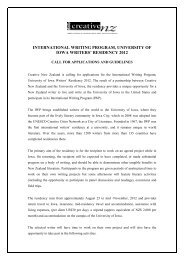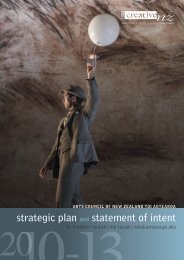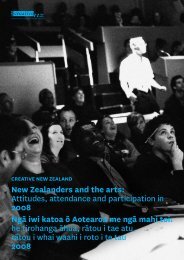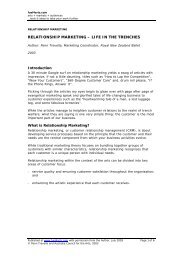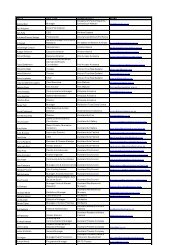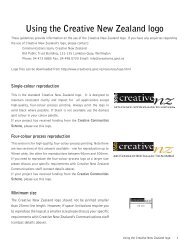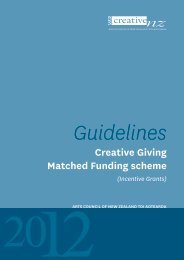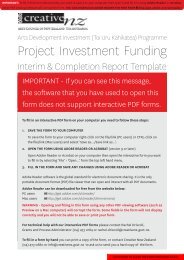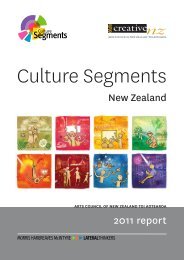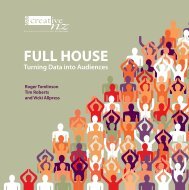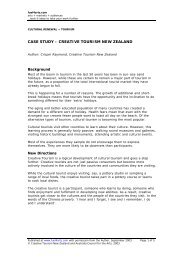Download PDF 626 KB - Creative New Zealand
Download PDF 626 KB - Creative New Zealand
Download PDF 626 KB - Creative New Zealand
You also want an ePaper? Increase the reach of your titles
YUMPU automatically turns print PDFs into web optimized ePapers that Google loves.
• Flickr: A lot of people had put up photos of their visit online. MoMA realised that<br />
many of these photos presented the visitors’ viewpoint and had more personality<br />
than the traditional art museum shots. It now invites visitors to a Flickr group where<br />
they can post photos, which can also be used by MoMA on its own website or in<br />
other contexts – always with the photographer’s permission.<br />
• You Tube: MoMA now has 306 videos on its You Tube site MoMAvideos. You Tube<br />
is the second most searched site outside Google, and people can take the videos<br />
you post and put them on blogs. Analytics enable you to know who is watching your<br />
video, as well as where, when and what they are watching.<br />
• 30 second videos: MoMA invited members and staff to create 30 second videos to<br />
express how they felt about MoMA and what they do there. The goal was to show the<br />
MoMA personality, the characters of staff, and members, and a “behind the scenes”<br />
perspective. Responses ranged from a wordless cartwheeling through the galleries,<br />
to a staff member talking to camera; from one staff member’s four-year-old's<br />
perspective to one of the operations team demonstrating how they turn on the lights<br />
at MoMA using a cardboard sword and waving at the lights whilst skipping through<br />
the gallery rooms.<br />
• Marina Abramovich exhibition”: This exhibition, titled The Artist is Present, had<br />
theartist herself sitting in the atrium and locking eyes with anyone prepared to sit<br />
opposite her. MoMA decided to test the waters with a live video feed of her sitting<br />
there. Who would want to watch? Turns out that hundreds of thousands did – MoMA<br />
had to put a 2 minute limit on how long anyone could watch to avoid completely<br />
bringing down the organisation’s servers. They also took a portrait photo of everyone<br />
who sat opposite her and put those up on Flickr. People took that content and made<br />
their own online content with it; they created games around identifying celebrities or<br />
friends; one person found all the photos of people crying and called the subsequent<br />
online “exhibition” ‘MoMA made me cry’. And someone even tweeted as if they were<br />
Marina Abramovich’s chair.<br />
• Andy Warhol screen tests: These were screened in one of the MoMA galleries, and<br />
people were invited to create their own 90second ‘screen test’ videos and upload<br />
them to Flickr. Over 680 videos were submitted.<br />
• I went to MoMA and…: Less technical, but with social media offshoots, this<br />
campaign invited people to complete the sentence, expressing their thoughts on their<br />
visit, and post it on a wall in the gallery. More than 2000 of the over 7000<br />
submissions have already been put on the MoMA website and another 2000 are<br />
about to be added. MoMA also used the responses in poster, billboard and banner<br />
campaigns over the following summer, as well as including some as blog content–<br />
and learned a lot about the MoMA experience for visitors. The initiative is ongoing<br />
and MoMA is about to introduce scanners so visitors can scan their response and<br />
make it immediately shareable online.<br />
• iTune U: Audio guides are posted so people can load them onto their own iPods.<br />
• Facebook: MoMA puts as much as it can on its site: upcoming and current<br />
exhibitions, maps, and other info. People “appreciate it when we post non-MoMA<br />
content. They trust that we are not trying to sell stuff constantly.” Again, monitoring<br />
tools tell MoMA what’s working and what isn’t.<br />
• Twitter: Some of the content put on Facebook also goes on Twitter. It’s also a way<br />
people can contact MoMA directly. Samra follows Twitter conversations and



